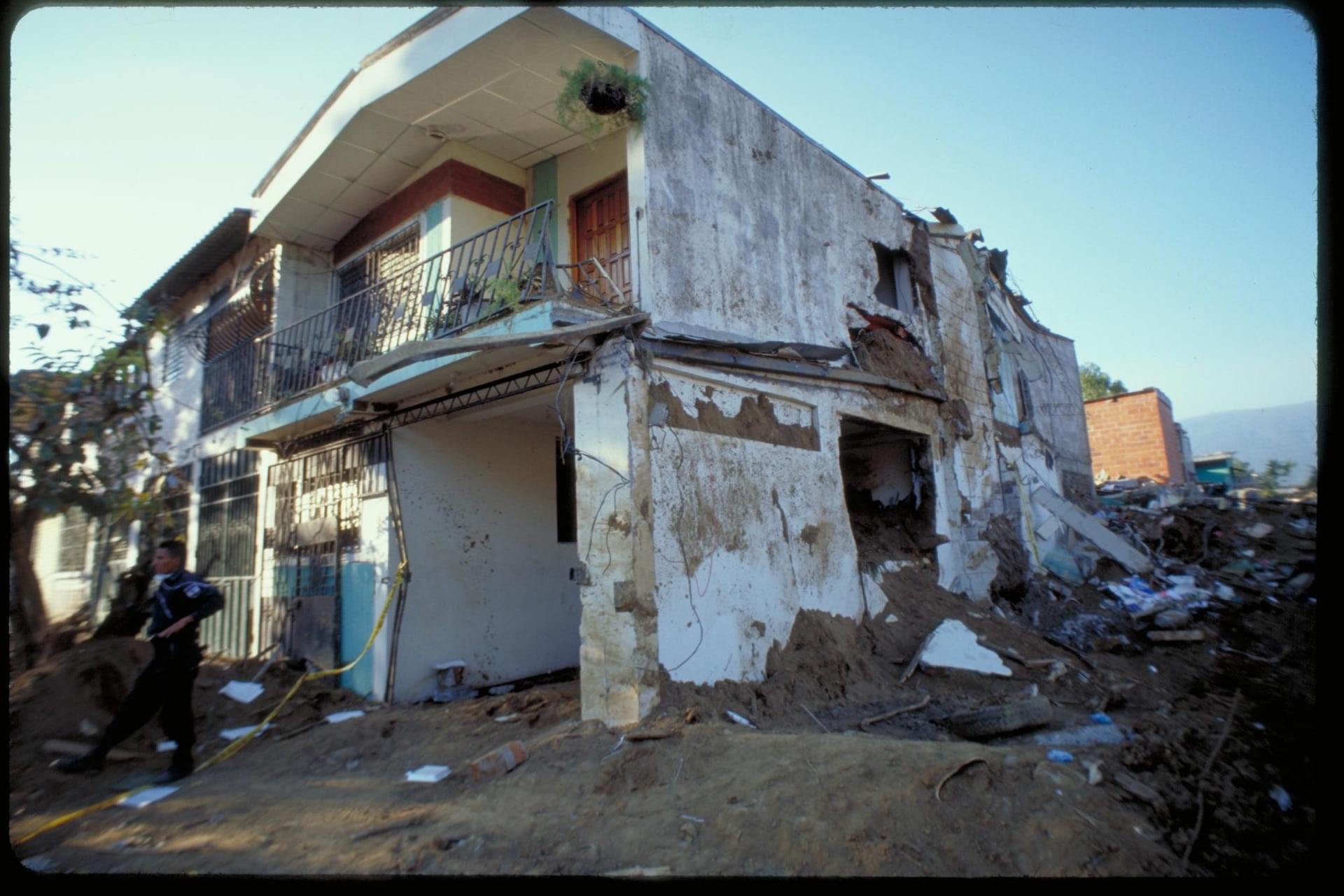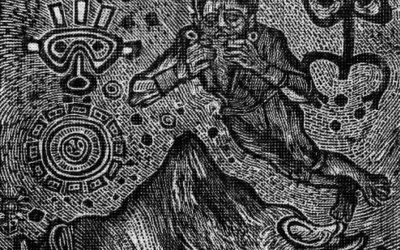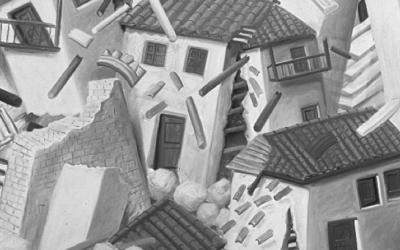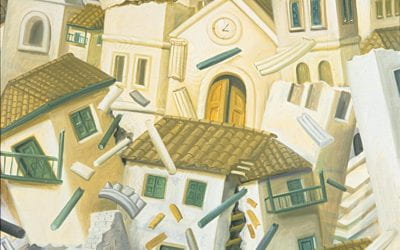Hurricanes, Society, and the Culture of Citizenship
A Latin American Round Table

Unlike hurricanes, it’s very difficult to predict an earthquake or volcano eruptions. Photo courtesy of the Pan American Health Organization.
Participants:
Rafael Hernández, moderator (Cuba)
Ricardo Flores (El Salvador)
Armando Fernández (Cuba)
Cristina Reyes (Cuba)
Alexis Lorenzo (Cuba)
Rafael Colmenares (Colombia)
Esther Pérez (Cuba)
José Mateo (Cuba
RAFAEL HERNÁNDEZ: Today’s discussion is on “Hurricanes, Society and the Culture of Citizenship.” In addition to physical destruction and the loss of human lives, hurricanes leave their imprint on nature, society, its way of thinking and the culture of citizenship. What are those imprints and in what sense are hurricanes different from other natural disasters?
RICARDO FLORES: In my country, we have a culture of earthquakes, drought and volcanic eruptions, rather than hurricanes. Three very fierce tropical depressions have affected us over the last 20 years: Mitch, Adrián, and Stan. Adrián sat out in the Pacific for about five days while the media warned people, “Adrián’s getting closer; go buy food and stock up on gas.” That is, Adrián became a commercial hurricane that swept away food and gas supplies. People got the idea that a full-strength hurricane was going to hit us, but it was largely a virtual hurricane that was good for the shopping centers. Hurricane Stan created a new phenomenon. San Salvador is situated in El Valle de las Hamacas—Hammock Valley—with constant seismic activity. It is normal to have 20, 25 tremors in a single day, but Stan, which principally affected the capital, flooded the entire lower part of San Salvador. We had always been a seismic city, and now we became a flooded city. Mitch swept away water reservoirs, made them disappear.
ARMANDO FERNÁNDEZ: The Caribbean is a zone where the hurricanes form a part of its inhabitants’ culture. If we look at indigenous peoples, we find that their pottery and ceramics depict hurricane images. In his book Huracán (Hurricane), Cuban scientist Fernando Ortiz reconstructs the symbolic imagery of the hurricane among native peoples. For the indigenous population, hurricanes brought water and a lot of wind, but not destruction. To a certain degree, the tempests marked a new and vital cycle for crops. However, the Conquest and colonization based themselves on the exploitation of nature. Thus, Cuban and Caribbean culture have incorporated this sense of disaster that does not exist in nature itself. Nature is, in this sense, amoral. Humans provide the concept of disaster, precisely because they are where they ought not to be. Western civilization has developed technology to predict hurricanes, which are the most predictable among so-called natural disasters. In contrast, while short-term anticipation is possible, it’s very difficult to predict an earthquake or a volcanic eruption But one can follow the course of a hurricane until it finally strikes.
CRISTINA REYES: Disaster does not exist in nature; what exists is the threat, which can be natural or manmade. Disaster is a consequence of this phenomenon, tied closely to the risks of its communities and with the vulnerability of both human beings and the environment.
Hurricanes affect human health in several ways. They leave psychological scars, both individual and collective, depending on the cultural and social conditions of the community and individuals, as well as their cultural and social preparation. Durings the 70s and 80s, there were few hurricanes in Cuba. Many youth had no historical memory of hurricanes. However, during the past few years, hurricanes have become more frequent and aggressive. We are, in a certain way, champions of hurricanes because they visit us constantly. Sometimes they become a factor that alters our daily life and even the way we behave.
ALEXIS LORENZO: Hurricanes leave direct and indirect losses. Perhaps the most complex to evaluate are the subjective ones that are produced in the human mind. In the book by Fernando Ortiz that Armando mentions, it is very interesting to see how the natives and the Spanish perceived the losses. In the Cuban case, the perception of the impact of the hurricane is not the same in Havana as in other zones of the country, and within Havana, the reaction varies from neighborhood to neighborhood.
RAFAEL HERNÁNDEZ: How would you compare the impact of a hurricane with other natural disasters?
RAFAEL COLMENARES: Colombia is a country that is not affected by hurricanes. However, on our Caribbean coast, flooding severely affects the population. In 2004, there were 150,000 people who suffered gravely because of flooding, and in 2005, more than 300,000. Hurricanes and tsunamis are concrete and devastating events, but flooding is longterm with a strong impact of another type.
RAFAEL HERNÁNDEZ: What causes the flooding?
RAFAEL COLMENARES: The winter rains, but actually the cause is a deeper one, the drying up of the swamps and marshes throughout the area. Cattleraising and other economic activities have contributed to the drying out of the wetlands, upsetting the hydraulic balance. During the rainy season we call winter, the water has no place to go and therefore produces flooding. And the flooding causes the displacement of people. In Cartagena, displacement has been aggravated because of increased migration there due to violence.
RAFAEL HERNÁNDEZ: The second question to consider is vulnerability and the perception of risk. To what degree is the perception of risk an important factor in the consequences of a hurricane?
RICARDO FLORES: Disaster is very much associated with a vulnerable population, in this case, a rural, poor and marginalized population that lives on the riverbanks. These natural phenomena make this population even poorer, but I also want to stress the problem of popular beliefs. People say, “It’s God’s punishment” or ”it’s because we are behaving badly” or “there’s too much violence.” So the natural phenomenon is not perceived as something predictable, but as a matter of divine will and punishment.
In terms of organization, we have a recently passed law that provides for civil protection and disaster prevention, but the government doesn’t pay any attention. They wait for the disaster to draw up emergency plans, at which point they call for urgent help and funds. This can later help them in their election campaigns, since they give out food and services to the population. Disasters have a very strong political element, especially in the use of the media.
CRISTINA REYES: Vulnerability is a factor that depends on the actions of human beings, closely tied to training and preparation. In the field of public health, we talk about the vulnerability of hospitals. We stress that “Health facilities have to be secure,” because we realize that that the functioning of a healthcare institution is also vulnerable during a disaster. This is true in communities around the world. As one colleague noted, in his country, the poorest communities suffer the most in a disaster; they are the most vulnerable; they are not well-prepared. Fortunately, this is not the case in Cuba. Here, housing may be vulnerable; it may not withstand a storm, but there is a system of information, communication and evacuation that has been proven to be quite effective.
In the last fifty years, natural disasters have increased by 142%. The poorest countries are those that have the most serious problems, suffer the most, and have the fewest possibilities of preparing, because these measures are associated with development. And sometimes countries—unlike Cuba—do not have enough resources to take preventative measures.
For an expert, the assessment of risk is the possibility that a disaster might occur; for the general public, it is a matter of common sense, depending on various social and cultural factors. How the population understands the catastrophic magnitude of the event determines its fear and anxiety, especially if the disaster could affect children’s lives. Communication is a very important element in the perception of risk. The Cuban people are informed when a storm is coming, and civil society is prepared to take measures. There is also the certainty that those who must resort to a shelter will have access to medical care and that people’s basic needs will be met. This element of certainty determines how risk is perceived.
ALEXIS LORENZO: In the last ten or fifteen years, science has done a lot to reduce vulnerability. I remember that when I was a boy, nobody believed in the phenomenon of El Niño. Hurricanes are not the intellectual property of one science, one profession. Other factors are culture, level of training, education, preparation, and all that is done before disaster actually strikes. Societies generally act during an event, but poor people most often have no preparation. When we compare the results in Cuba—a country with few economic resources—in the face of such devastating phenomena like Hurricane Mitch, we can observe how preparation has a great effect on communities, individuals and families. We have experience with children and adolescents, with no historical memory of hurricanes, who are nonetheless aware of elevated risk. Science and technology are essential, but insufficient. The human factor, as I see it, continues to be the most important one.
ARMANDO FERNÁNDEZ: I agree with Alexis, and I’ll go even a little further. Technical instruments, both the technological and organizational, offer us the possibility of forecasting. When I refer to organizational instruments, I think of land organization. In Cuba, unlike other Latin American countries, the land and, in particular, the urban sector, has been well organized, a basic factor in the enforcement of policies and risk reduction. Nature has cycles that are longer than a human lifetime and thus, many human beings do not take them into account. According to meterologists, hurricane cycles come about every 25 or 30 years, and we are now beginning a cycle of high frequency, exacerbated by climate change. Because of this, water rises higher along the coastline and low-lying areas of cities such as Havana, creating the additional risk of flood. When these areas were urbanized in the 1950s or earlier, this problem of land organization was not taken into account.
RAFAEL COLMENARES: The well-know equation is that risk is equal to the amount of threat, multiplied by the amount of vulnerabilty. We can most easily change the latter part of the equation, but there are two factors, one structural and the other depending more on specific circumstance. The structural is more or less what Armando is talking about; if we have a model of land occupancy or a system of production that violates the logic of ecosystems, we are generating a great vulnerability. That is precisely what is happening on the Colombian coast. If we dry out the marshes in areas that flood easily, or if we construct housing on mountainsides in seismic zones, we are creating more vulnerability. This happens with frequency in all our countries.
The other factor is prevention, tied to information and adequate social and political organization. In Colombia, after the Armero disaster—where the eruption of the Ruíz volcano set off an avalanche that buried an entire town—communication and alert systems were substantially improved. This was the origin of the National System of Disaster Prevention, an excellent system both on paper and in practice. During the last two years, the Galera volcano in Pasto near the Ecuadorean border has constantly threatened to erupt. The alert system has functioned very well; people have been evacuated in a timely fashion. However, the flooding I have been telling you about has no such alert system.
Finally, I would like to talk a bit about the collective imaginary . When conditions do not exist to resist a disaster, a certain kind of fatalism takes over: “God wants it this way; we have been sinners, and this is our punishment.” I would compare this to a situation that attracted my attention a couple of years ago and that, in my opinion, environmentalists ought to publicize more. When the tsunami hit Asia, it was believed that two small islands in the Indian Ocean, Andamán and Nicobar, had been destroyed, along with their aboriginal cultures. Some fifteen days later, it was found that the islands were actually intact and that not one single person had died. Why? Because the natives knew how to read nature’s messages and retreated to the high points of the island to wait until the tsunami passed. The United States wants to sell India a very sophisticated device to predict tsunamis. Someone questioned, What sense is there in buying such sophisticated forecast systems, when these aborigines have shown us we need to be closer to nature, to understand it, to be able to read its signals, and, above all, to have an adaptive culture, capable of coexisting with this logic of nature.”
RAFAEL HERNÁNDEZ: Would you say that our perception of risk might be distorted if we believed we live in a safe house, had access to the necessary health services and had alternative sources of informations such as battery-operated radios if the lights go out?
ESTHER PÉREZ: All of the interventions so far—at least from reading between the lines—have spotlighted the problem of political will. There is an excellent study by Martha Thompson about risk reduction and disaster mitigation in Cuba. She recounts—about Mitch in Guatemala, I believe—how a community located in a vulnerable zone was much less affected because it had organized for the war. The political will of the community meant that the residents not only recognized the risk, but followed their leaders in an emergency plan in the same way as it had organized to defend itself in the war.
Winter 2007, Volume VI, Number 2
Rafael Hernández is a senior research fellow at the Centro de Investigación y Desarrollo de la Cultura Cubana Juan Marinello in Havana. Founding editor of TEMAS, a Cuban quarterly in the field of social sciences and the humanities, he was the 2006-07 Robert F. Kennedy (RFK) Visiting Professor in Latin American Studies.
Related Articles
Editor’s Letter: Natural Disasters
We were little black cats with white whiskers and long tails. One musical number from my one and only dance performance—in the fifth grade—has always stuck in my head. It was called “Hernando’s Hideaway,” a rhythm I was told was a tango from a faraway place called Argentina.
After the Earthquake: Juan’s Life
Juan was a construction helper. He lived in Armenia, but his parents were from the Antioquia region, who had fled because of the violence there. The mother of his children was called…
Political Memory
Late in 1717 Dr. Joseph Surin, precentor of the Cathedral of Old Guatemala, carried out some calculations: had the mudslide that wiped the city on the 28th of August, feast day of Saint…




